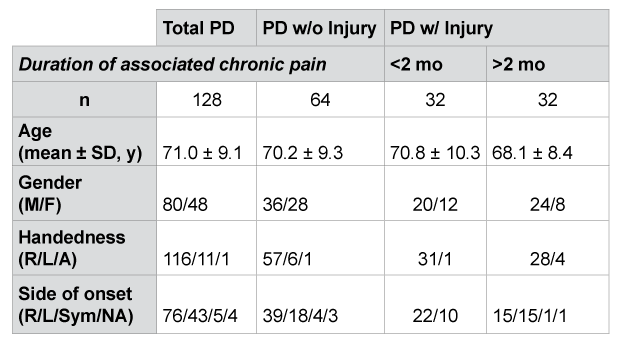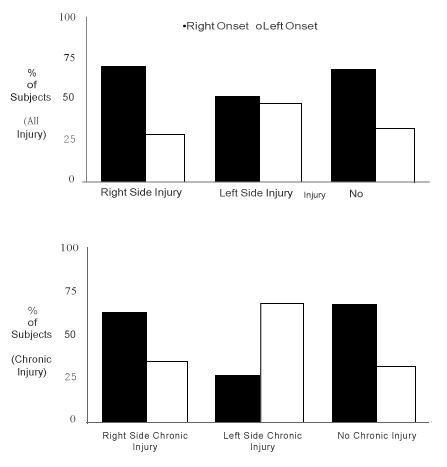Abstract
Background
Parkinson’s disease (PD) motor symptoms are frequently asymmetric and the factors that influence the side of onset are unclear.
Objective
To explore whether peripheral injury and associated chronic limb pain may influence the side of onset.
Methods
We administered a questionnaire to 128 PD patients in a tertiary movement disorder clinic. Handedness, date and type of limb injury(s) and duration of associated pain, and date and side of onset were ascertained.
Results
Sixty-two subjects reported limb injuries prior to the onset of PD symptoms, 30 with and 32 without chronic pain (i.e., ≥ 2 months). There was no association between injury and PD onset side overall (p=0.334). In subjects with chronic pain associated with limb injuries, however, side of injuries was associated with the side of PD symptom onset (p=0.030).
Conclusions
Limb injury with chronic pain may be related to the side of PD symptom onset. Future studies may shed light on the nature of this observation.
Keywords
Parkinson’s disease; Peripheral limb injury; Side of onset; Handedness
Introduction
Parkinson’s disease (PD) is marked by neuronal loss in the substantia
nigra that results in decreased dopaminergic input into the basal ganglia
(BG) [1]. PD motor symptoms like bradykinesia, rigidity, resting tremor,
and gait difficulties often present asymmetrically [2]. The factors that are
associated with or influence side of PD onset are, however, unclear.
Handedness has been investigated as a probable cause for asymmetric
onset of PD motor symptoms, and there appears an overall link between
dominant hand and PD side of onset [3]. The association, however, only
accounts for PD side of onset in 60% of subjects. This suggests that other
factors may contribute to the determination of PD onset side.
Peripheral nerve injury is related to several movement disorders such
as dystonia, and sometimes associated with laterality [4,5]. It has been
proposed that sensory input from peripheral nerve injuries may modulate
BG-related brain circuitry, particularly if the injuries were intense and
persistent [5]. The current study was designed to explore whether limb
injury and associated pain may be related with the side of onset in PD.
Methods
We conducted a retrospective study on 116 controls and 128 subjects
with PD who presented consecutively to a movement disorder clinic
between May 1, 2012 and December 31, 2012. Detailed demographic data
for the subjects are provided in Table 1. Controls were companions of
the subjects. PD diagnosis was confirmed [6] by a movement disorders
specialist (XH) who also ascertained the side of symptom-onset via
congregant history and physical exam. Initial date of disease onset was
obtained through personal subject history, along with age, gender,
and handedness. The study was approved by the Penn State Hershey
Institutional Review Board and was conducted in accordance with the
principles of the Declaration of Helsinki.
Past injury history was obtained via a short questionnaire
(Supplementary Table). The questionnaire consisted of six questions
regarding previous limb injury serious enough to require medical
attention. The interview was conducted by an investigator (IT) blinded to
side of PD onset. Arbitrarily, past injuries and pain that persisted ≥ two
months were defined as chronic. Because some subjects may have endured
multiple limb injuries in their lifetime, we developed a system to assess the
dominant side of past limb injuries. First, we generated a scoring system
to gauge the intensity and duration of pain associated with each injury
(Supplementary Table 2). Then, we obtained a composite score of each
injury by multiplying the intensity score with the duration score. The
dominant injury side was defined as the side with the highest combined
score.

Table 1: Description of Parkinson’s subjects*
*These numbers do not reflect subjects that have been excluded from the analyses. Abbreviations: Mo = month; PD = Parkinson’s disease; R/L/ A= Right/Left/Ambidextrous;R/L/Sym/NA = Right/Left/Symmetrical/Not applicable.
We compared demographic and clinical characteristics for the groups
by t-test, chi-square test, and Fisher’s exact test, as appropriate. The effects
of injury and handedness on side of PD onset were evaluated by Fisher’s
exact tests. The Cochran-Mantel-Haenszel test was used to assess the
association between injury and side of PD onset. A two-sided p value of
<0.05 was considered statistically significant.
Results
Of the 128 PD subjects, 126 PD subjects were able to answer the
limb injury questionnaire. Among them, 62 (49%) subjects experienced
injury(s) versus 55 of 116 controls (47%; p=0.780). Among the 128
PD subjects, 114 PD subjects had known history of injuries and clear
asymmetrical side of onset, and were included in the analysis for the effect
of injury on PD onset side.
The side of injury had no significant influence on the side of onset in
subjects with both acute and chronic injuries (p=0.334, Figure 1, top).
There was, however, a significant influence of side of injury with chronic
pain on PD side of onset, with concordant rates of 64% and 73% for right
and left side injury and onset, respectively, (p=0.030, Figure 1, bottom).
After adjusting for handedness, the trend persisted (p=0.067).
Discussion
The factors underlying the asymmetric presentation of PD have puzzled
the field. This study explored for the first time the potential relationship
between limb injury and PD side of onset. The results do not support
the notion that limb injury is associated with PD side of onset; however,
chronic pain associated with injury may be linked to the side of PD onset.
The latter observation is both novel and intriguing, although the exact
nature of the association is unknown.
In the past, animal experiments have shown that peripheral limb
injury can modulate brain function [4,7]. Animals subjected to thermal
injury have been shown to have reduced movement of the affected limb,
and decreased enkephalin content of the globus pallidus, especially after
prolonged duration [4]. In addition, peripheral injury also has been
implicated in dystonia [4,5,8]. Thus, it is possible that peripheral limb
injury may modulate the BG and influence the side of symptom onset
of PD. On the other hand, it is well known that PD can affect many nonmotor
systems. Chronic pain has been known to be part of PD, as many
PD patients have reported differential pain [9], and levodopa has been
shown to be associated with increased pain threshold in PD [10]. Thus, it
is conceivable that higher chronic pain from limb injuries may represent
the lower pain threshold in the pre-PD state.

Figure 1: Distribution of subjects with a history of peripheral injury
and PD side of onset. The numbers on top of the columns indicate the number of subjects in each group. The upper panel describes all PD subjects separated by right side injury, left side injury, and no history of injury. The bottom panel shows the distribution of subjects according to their chronic injury side and whether they have suffered chronic pain due to injury.
This study is limited by being relatively small scale, retrospective, and
the arbitrary categorization of injuries. In addition, we did not account
for other conditions associated with chronic limb pain. Nevertheless, this
is the first exploration of whether there is a link between chronic pain
associated with past limb injury and side of PD onset. The results warrant
future studies, and may have important clinical and basic scientific
implications.
Acknowledgements
We thank Ms. Brittany Jones for assisting subject surveys and Drs.
Milind J. Kothari and Richard B. Mailman for their valuable input during
the preparation of this manuscript. This work was supported in part by the
National Institutes of Health (NS060722, NS082151 and ES019672 to XH),
the Penn State Clinical & Translational Science Institute, Pennsylvania
State University CTSA (UL-1RR033184 to XH), and the Pennsylvania
Department of Health Tobacco Settlement Funds (C06 RR016499 to XH).
Disclosure of Conflicts of Interest
None of the authors have any to disclose.
Article Information
Aritcle Type: Short Communication
Citation: Tekin I, Vgontzas A, Lewis MM, Kothari S, Kong L, et al. (2015) Previous Injury and Chronic Pain are Associated with Side of Onset in Parkinson’s Disease. J Neurol Neurobiol 1(3): doi http://dx.doi.
org/10.16966/2379-7150.109
Copyright: © 2015 Tekin I, et al. This is an open-access article distributed under the terms of the Creative Commons Attribution License, which permits unrestricted use, distribution, and reproduction in any medium, provided the original author and source are credited.
Publication history:
Received date: 3 July 2015
Accepted date: 20 July 2015
Published date: 25 July 2015



